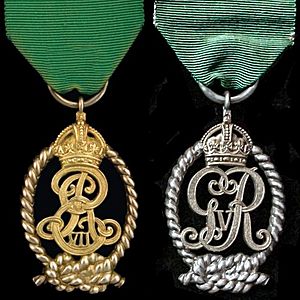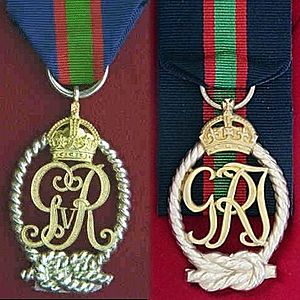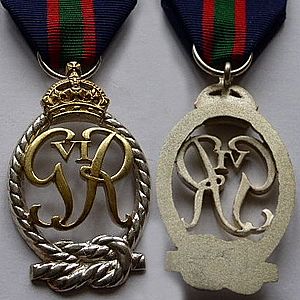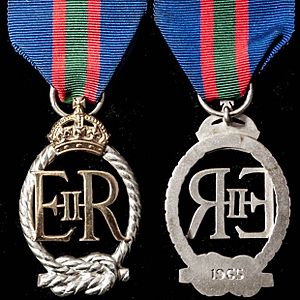Decoration for Officers of the Royal Naval Volunteer Reserve facts for kids
Quick facts for kids Decoration for Officers of the Royal Naval Volunteer Reserve |
|
|---|---|

King Edward VII and first King George V versions with original all-green ribbons
|
|
| Country | |
| Type | Military long service decoration |
| Eligibility | Part-time commissioned officers of the Royal Naval Volunteer Reserve |
| Awarded for | Twenty years service |
| Status | Still current in New Zealand |
| Clasps | Ten years additional service |
| Post-nominals | VD until c. 1947 VRD from c. 1947 |
| Statistics | |
| Established | 1908 |
| Order of wear | |
| Next (higher) | Decoration for Officers of the Royal Naval Reserve |
| Next (lower) | Royal Naval Reserve Long Service and Good Conduct Medal |
Original and post-1919 ribbon bars |
|
The Decoration for Officers of the Royal Naval Volunteer Reserve was a special award given to part-time officers in the Royal Naval Volunteer Reserve. It started in 1908. Officers earned it for 20 years of excellent service.
This award was like a naval version of other decorations given to volunteer officers. At first, officers who received it could use the letters VD after their name. Later, around 1947, this changed to VRD.
The decoration was also given to part-time officers in similar naval volunteer groups across the British Empire. The United Kingdom stopped giving out this award in 1966. This happened when the Royal Naval Volunteer Reserve, made of civilian volunteers, joined with the Royal Naval Reserve, which included sailors from the Merchant Navy.
Today, a similar version of this award is still given in New Zealand.
Contents
What Is This Award?
This decoration was created to recognize officers who served for a long time. It was for those who volunteered their time to serve in the Royal Naval Volunteer Reserve. These officers were part-time, meaning they had other jobs too.
The award was given to officers in the United Kingdom and other parts of the British Empire. It was one of two similar awards created at the same time. The other was for officers in the Royal Naval Reserve.
How the Award Started
Before this award, there were other decorations for volunteer officers. In 1892, the Volunteer Officers' Decoration was created for officers in the United Kingdom's volunteer army. Later, this award was also given to volunteer officers across the British Empire.
In 1908, new awards were created. The Decoration for Officers of the Royal Naval Volunteer Reserve was one of them. It was made specifically for naval volunteers.
Countries That Used It
Many countries in the British Empire also used this decoration.
- South Africa started using it in 1915.
- New Zealand began using it in 1925.
- Canada adopted it in 1938.
The first officer to receive this decoration was Lieutenant Charles Alfred Jones in 1909.
How to Earn the Award
Officers in the Royal Naval Volunteer Reserve could earn this decoration after 20 years of service. Their service did not have to be continuous. They also had to be efficient and capable officers.
Time spent serving during wartime counted as double time. Also, half the time an officer served as a regular sailor could count towards the award. However, an officer had to serve at least seven years in the Royal Naval Volunteer Reserve to be eligible.
If an officer had already received a medal for long service as a regular sailor, they could still get this decoration. They could even wear both awards.
Extra Awards: Clasps
After 1954, officers could earn an extra award called a "clasp." A clasp is a bar attached to the ribbon of the decoration. Officers earned a clasp for every 10 additional years of service after receiving the main decoration.
What the Decoration Looks Like
The decoration is shaped like an oval. It is made of silver, with some parts on the front made of silver-gilt (silver covered with a thin layer of gold). The award is about 56 millimeters (2.2 inches) tall and 35 millimeters (1.4 inches) wide.
The Front of the Award
The front of the decoration shows the royal symbol of the king or queen who was ruling at the time. This symbol is in silver-gilt. It is surrounded by a silver rope tied with a special knot at the bottom. A silver-gilt crown sits at the top, where the ribbon attaches.
There have been five different versions of the decoration, each with a different royal symbol:
- The first version (1908) had King Edward VII's symbol ("ERVII").
- The first King George V version (after 1910) had his symbol ("GVR").
- The second King George V version had a different symbol ("GRI").
- The King George VI version (after 1936) had his symbol ("GVIR").
- The Queen Elizabeth II version (after 1952) had her symbol ("EIIR").
The Back of the Award
The back of the decoration is smooth and plain. Usually, the year the award was given is stamped on the back. If it was awarded in other countries, the recipient's name might be engraved instead.
The Clasp
The clasp, added around 1954, has Queen Elizabeth II's royal symbol ("EIIR") in the middle. It also has a small crown on top. The year the clasp was awarded is stamped on its back. When officers wore their everyday uniform, they would wear a small silver flower on their ribbon bar to show they had a clasp.
The Ribbons
Two different ribbons were used with this decoration.
- The first ribbon was dark green. It was 38 millimeters (1.5 inches) wide.
- A new ribbon was introduced around 1919. It was also 38 millimeters wide. This ribbon had a wide navy blue stripe, a narrow dark red stripe, a dark green stripe, and then the red and blue stripes repeated in reverse. The colors have special meanings: blue for the sea, red for royalty, and green for the original volunteer decoration.
Where It Ranks Among Awards
In the United Kingdom, this decoration ranks after the Decoration for Officers of the Royal Naval Reserve. It ranks before the Royal Naval Reserve Long Service and Good Conduct Medal.
In South Africa
South Africa created its own military awards in 1952. These new South African awards were worn before most older British awards. However, the Victoria Cross always ranked highest. Among the British medals still worn by South Africans, this decoration ranked as shown:
- It was worn after the Efficiency Medal (South Africa).
- It was worn before the Royal Naval Volunteer Reserve Long Service and Good Conduct Medal.
When the Award Ended
New Zealand still gives out a version of this award today. However, in the United Kingdom and some other Commonwealth countries, new awards gradually replaced it.
- Canada stopped giving out its version of the award in 1946.
- South Africa replaced it in 1952 with the John Chard Decoration.
- In the United Kingdom, this decoration was stopped in 1966. This happened when the Royal Naval Volunteer Reserve joined with the Royal Naval Reserve. The award was then replaced by the Decoration for Officers of the Royal Naval Reserve.




